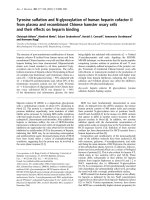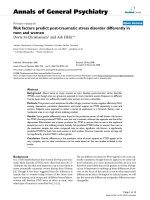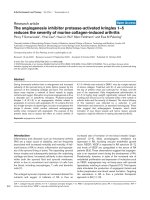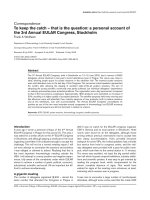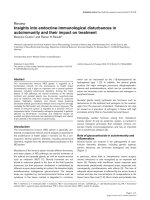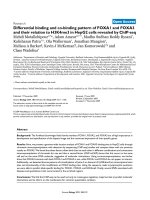Báo cáo y học: "Psychosocial factors and their role in chronic pain: A brief review of development and current stat" ppsx
Bạn đang xem bản rút gọn của tài liệu. Xem và tải ngay bản đầy đủ của tài liệu tại đây (239.5 KB, 5 trang )
BioMed Central
Page 1 of 5
(page number not for citation purposes)
Chiropractic & Osteopathy
Open Access
Review
Psychosocial factors and their role in chronic pain: A brief review of
development and current status
Stanley I Innes*
Address: Private Practice 35 Maroondah Highway, Lilydale, 3140, Australia
Email: Stanley I Innes* -
* Corresponding author
Abstract
The belief that pain is a direct result of tissue damage has dominated medical thinking since the mid
20
th
Century. Several schools of psychological thought proffered linear causal models to explain
non-physical pain observations such as phantom limb pain and the effects of placebo interventions.
Psychological research has focused on identifying those people with acute pain who are at risk of
transitioning into chronic and disabling pain, in the hope of producing better outcomes.
Several multicausal Cognitive Behavioural models dominate the research landscape in this area.
They are gaining wider acceptance and some aspects are being integrated and implemented into a
number of health care systems. The most notable of these is the concept of Yellow Flags. The
research to validate the veracity of such programs has not yet been established.
In this paper I seek to briefly summarize the development of psychological thought, both past and
present, then review current cognitive-behavioural models and the available supporting evidence. I
conclude by discussing these factors and identifying those that have been shown to be reliable
predictors of chronicity and those that may hold promise for the future.
Introduction
There is an increasing interest and acceptance in psycho-
social factors and their correlations to the onset and out-
comes of acute pain episodes. This review will briefly
review its evolution and summarize the past and present
theoretical models in relation to low back pain (LBP). Psy-
chlit, MEDLINE and medindex searches were conducted to
identify relevant articles with the search words 'psycholog-
ical factors, chronic/persistent pain'.
Historical development
The psychological and psychiatric aspects of pain had
been infrequently noted by modern writers as early as
1768. For a comprehensive historical review see Merksy &
Spear [1]. By the second half of the 19th Century, how-
ever, pain was considered sensorial and organic causes
were offered to explain all pains, even those without an
obvious basis in tissue damage or organic disease. The
belief that all pain was a direct result of tissue damage was
firmly entrenched by the early 20th Century [2].
By the late 1950's it became increasingly evident that sen-
sory explanations failed to account for certain puzzling
pain phenomena (e.g., relief from pain with placebo
interventions, phantom limb pain). Around the mid-20
th
Century several different theories were developed from
differing theoretical backgrounds to explain the observa-
tion that sensory input did not always correlate with pain.
I have summarized these differing schools of thought by
précising a comprehensive review by Gamsa [3,4].
Published: 27 April 2005
Chiropractic & Osteopathy 2005, 13:6 doi:10.1186/1746-1340-13-6
Received: 09 April 2005
Accepted: 27 April 2005
This article is available from: />© 2005 Innes; licensee BioMed Central Ltd.
This is an Open Access article distributed under the terms of the Creative Commons Attribution License ( />),
which permits unrestricted use, distribution, and reproduction in any medium, provided the original work is properly cited.
Chiropractic & Osteopathy 2005, 13:6 />Page 2 of 5
(page number not for citation purposes)
Psycholanalytic Formulations
Here intractable pain, which defies organic explanations,
was seen as a defence against unconscious conflict. Emo-
tional pain is displaced onto the body where it is more
bearable. For example, conscious or unconscious guilt
with pain serving as a form of atonement, or the develop-
ment of pain to replace feelings of loss. Critics have raised
serious methodological and conceptual concerns [5,6].
For example; the ability to quantify and research the con-
structs of Id, ego and superego. Psychoanalytic thinking
no longer forms a significant basis for research or source
of current interventions.
Behaviourist Models
Following the work of Skinner [7], behaviourists tried to
show that all behaviour could be shaped, altered, weak-
ened or strengthened as a direct of environmental manip-
ulations. Fordyce et al. [8] were the first to apply the
behaviour model to pain. It was thought that there was a
simple causal connection between pain and its reinforc-
ers. Respondent (acute) pain was seen as a reflexive
response to antecedent stimulus (tissue damage). The
respondent pain may eventually evolve into operant and
persisting pain if the environment offers pain contingent
reinforcement. Pain behaviour may also be learned by
observing "pain models" i.e., individuals who exhibit
such behaviour. More complex factors such as personal
dynamics, emotional state, physical vulnerability, and
numerous psychosocial variables were not addressed. It
proposed that operant pain persists because the behaviour
of others (family, friends and health care providers) dur-
ing the acute pain stage reinforced that pain returned sec-
ondary gains, such as permission to avoid chores, or
obtain otherwise unobtainable attention and care. Behav-
iour models have however contributed to the study of
pain by the introduction of carefully designed control
procedures and laboratory methods [4].
Cognitive Approaches
Cognitive approaches were inspired in part by Melzack
and Wall's [9] gate control theory, which established a
role for the cognitive-evaluative process in the modula-
tion of pain. Since the mid 1970's proponents of cognitive
theory studied the influence of the meaning of pain to
patients, and examined the effect of coping styles on pain,
for further review see Weisenberg [10]. Cognitive theory
examines intervening variables such as attributions,
expectations, beliefs, self-efficacy, personal control, atten-
tion to pain stimuli, problem solving, coping self-state-
ments and imagery. Pain studies investigated the effects of
these thought processes on the experience of pain and
related problems. Cognitive theory has added an impor-
tant dimension to psychological research into pain, but
cognitive theorists themselves emphasise that they do not
provide the solution, in isolation from other aspects of the
multidimensional problem of pain [4,19]. The combina-
tion of cognitive and behavioural approaches has been
employed extensively in pain programmes during the last
15–20 years with some reported success [11].
Psychophysiological Approaches
Examines the influence of mental events (thoughts mem-
ories and emotions) on physical changes which produce
pain, for a comprehensive review see Flor and Turk [12].
For example, general arousal models propose that fre-
quent or prolonged arousal of the Autonomic Nervous
System (ANS) including prolonged muscular contrac-
tions, generate and perpetuate pain. Treatment, such as
EMG, biofeedback, and relaxation techniques are
designed to decrease the levels of muscular tension and
ANS arousal and thereby decrease the pain. Studies have
shown positive results from these interventions, but not
necessarily more than other psychological techniques
[3,4].
In sum, psychological thought during the past half cen-
tury has shifted from linear to multicausal models of pain.
Methods of investigation have also improved.
Current theoretical models
A substantial number of acute painful musculoskeletal
injuries do not resolve quickly and account for the major-
ity of the associated costs [13]. Early intervention appears
to result in improved outcomes [14]. Consequently, it is
not surprising that the on-going evolution of the under-
standing of the non-physical aspects of pain has been
applied to the areas of screening for, intervening in and
predicting those at risk of developing into a chronic and
disabling situation [15,16,33]. The recent New Zealand
Government review into LBP, its subsequent published
guidelines, and resultant growing acceptance of the "Yel-
low Flags" concept is a pertinent example [17-19]. Varia-
bles such as attitudes, beliefs, mood state, social factors
and work appear to interact with pain behaviour, and are
cumulatively referred to as psychosocial factors. However,
to date there has not been developed a comprehensive,
multivariate and empirically supported Integrated Biopsy-
chosocial Risk-for-Disability Model. During a plenary ses-
sion at the Forth International Forum on LBP Research in
2000 [20] Pincus et al amalgamated the Cognitive and
behavioural thinking and proffered the closest structure
yet to such a model. It has sought to incorporate many of
these factors, and as such offers a structure from which to
review these psychosocial factors.
The cognitive-behavioural researchers in the late 20
th
cen-
tury noted that acute pain was associated with a pattern of
physiologic responses seen in anxiety attacks, whilst
chronic back pain was characterized more effectively by
habitation of autonomic responses and by a pattern of
Chiropractic & Osteopathy 2005, 13:6 />Page 3 of 5
(page number not for citation purposes)
vegetative signs similar to those seen in depressive disor-
ders. One of the prominent researchers, Waddell, noted
that one of the striking findings was that "fear of pain was
more disabling than the pain itself" [21]. As a result the
notion that reduced ability to carry out daily tasks was
merely a consequence of pain severity had to be reconsid-
ered. Several studies have indicated that pain-related fear
is one of the most potent predictors of observable per-
formance and is highly correlated to self-reported disabil-
ity levels in subacute and chronic pain [22,23].
In the acute pain situation, "avoidance" behaviours, such
as resting, are effective in allowing the healing process to
occur [24]. In chronic pain patients, the pain and disabil-
ity appear to persist beyond the expected healing time for
such a complaint. The danger is that a protracted period of
inactivity, as a strategy for coping with the persistent pain
may lead to a disuse syndrome (see Figure 1). This is a det-
rimental condition. It is associated with physical decondi-
tioning such as loss of mobility, muscle strength and
lowered pain thresholds (allodynia). Consequently, the
performance of daily physical activities may lead more
easily to pain and physical discomfort. As a result, the
avoidance of activity becomes increasing likely, as does
the risk of chronicity. Cognitive-behavioural theorists
have variously described this process that leads to chronic-
ity stemming from pathological levels of fear / anxiety as
"Fear of pain" [25], fear of physical activity and work
[26,27], avoiders and confronters [28], kinesiophobia
[29] and anxiety sensitivity [30].
When a person experiences pain they experience varying
degrees of psychological distress. A recent study suggests
that as many as one third of people seeking care at physi-
cal therapists may have significant levels of distress [31].
Many dimensions of this process have been identified and
their role posited in the development of chronicity.
One such example is catastrophic thinking processes and
is broadly described as an exaggerated orientation towards
pain stimuli and pain experience [32]. Negative appraisals
about pain and its consequences have been postulated to
be a potential precursor to persistent pain. People who
consider pain as a serious threat to their health are more
likely to become fearful as compared with those who
approach pain as a trivial annoyance [33].
Pain-related fear can also contribute to disability through
interference with cognitive functions. Fearful patients will
tend more to possible signals of threat (hyper-vigilance)
and will be less able to shift attention away from pain
related information at the expense of other tasks, includ-
ing actively coping with problems of daily life [34].
Although these and other factors such as coping strategies
[35], sense of control [36], personality type [37], faith and
religious beliefs [38], have been reported in literature (for
a comprehensive review see Keefe et al.[44], the most sig-
nificant and reproducible factors have been mood /
depression and to a lesser extent somatization / anxiety
[16,39]. Depression has been associated with decreased
pain thresholds and tolerance levels, reduced ability, gen-
eral withdrawal and mood disturbance such as irritability,
anhedonia (loss of enjoyment of good things in life), frus-
tration and reduced cognitive capacity.
Somatization disorder is a chronic condition in which
there are numerous physical complaints. It is perceived as
very similar in nature to, and difficult to differentiate from
an anxiety disorder [40]. The most common characteristic
of a somatoform disorder is the appearance of physical
symptoms or complaints for which there is no organic
basis. Such dysfunctional symptoms tend to range from
sensory or motor disability, and hypersensitivity to pain.
This is a difficult and complex syndrome and is more fully
dealt with elsewhere [41].
A cognitive-behavioural model of pain related fear [43]Figure 1
A cognitive-behavioural model of pain related fear [43].
injury / strain
disuse
depression recovery
disability
PAIN
avoidance
hypervigilance
muscle reactivit
y
fear of pain confrontation
movement / reinjury
catastrophizing no fear
Chiropractic & Osteopathy 2005, 13:6 />Page 4 of 5
(page number not for citation purposes)
A mention should be made of occupational factors. Job
dissatisfaction has repeatedly demonstrated itself to be a
significant factor in disability / persistent pain studies. The
most recent literature has implicated such factors as sup-
port from supervisors at work and low job control (i.e.,
inadequate power to make decisions and utilize one's
skills) which can create distress, and, when perpetual, may
result in ill health [42].
Conclusion
In sum, while this cognitive-behavioural model focused
on fear / avoidance shows much promise; it has yet not
been validated by the research to date [15]. There are stud-
ies in progress that may further our knowledge of identi-
fying those at risk of progressing from acute to chronic
[13]. Until the veracity of this model becomes further elu-
cidated, depression and somatization / anxiety should be
regarded as the central and dominant influencing psycho-
logical factors in the assessment for identification and
intervention strategies.
Competing interests
The author(s) declare that they have no competing
interests.
References
1. Mesky H, Spear FG: Pain: Psychological and psychiatric aspects Bailliere,
Tindall and Cassell: London; 1967.
2. Bonica JJ: Pain research and therapy, achievements of the past
and challenges of the future (IASP Presidential Address). In
Advances in Pain Research and Therapy Edited by: Bonica JJ. Raven Press,
New York; 1983:1-36.
3. Gamsa A: The role of psychological factors in chronic pain. 1
A half century of study. Pain 1994, 57:5-15.
4. Gamsa A: The role of psychological factors in chronic pain. 2
A critical appraisal. Pain 1994, 57:17-29.
5. Roy R: Pain prone patient: A revisit. Psychotherapy 1982,
37:202-213.
6. Roy R: Engel's pain-prone disorder patient: 25 years after,
Psychotherapy. Psychosomatic 1985, 43:126-135.
7. Skinner BF: Science and Human Behaviour MacMillan: New York; 1953.
8. Fordyce WE, Fowler RS, Lehmann JF, De Lateur BJ: Some implica-
tions of learning in problems of chronic pain. J Chronic Disability
1968, 21:179-190.
9. Melzack R, Wall PD: Pain mechanisms: a new theory. Science
1965, 150:971-979.
10. Weisenberg J: Cognitive aspects of pain. In Textbook of pain 2nd
edition. Edited by: Wall PD, Melzack R. Churchill Livingston:
Edinburgh; 1989:231-241.
11. Patrick LE, Altmaier EM, Found EM: Long-term outcomes in
multidisciplinary treatment of chronic low back pain: Results
of a 13-year follow-up. Spine 2004, 29:850-855.
12. Flor H, Turk DC: Psychophysiology of chronic pain: do chronic
pain patients exhibit symptom-specific psychophysiological
responses? Psychol Bull 1989, 105:215-259.
13. Turner JA, Franklin G, Fulton-Kehoe D, Egan K, Wickizer TM, Lymp
JF, Sheppard L, Laufman JD: Prediction of chronic disability in
work-related muscolskeletal disorders: a prospective, popu-
lation-based study. BMC Musculoskeletal Disorders 2004, 5:14-21.
14. Feldman JB: The prevention of occupational low back pain dis-
ability: Evidence-based reviews point in a new direction. Jour-
nal of Surgical Orthopaedics 2004, 13:1-14.
15. Pincus T, Vlaeyen JWS, Kendall NAS, Von Korff MR, Kalaukalani DA,
Reiss S: Cognitive-Behavioural therapy and psychosocial fac-
tors and low back pain. Spine 2002, 27:133-138.
16. Pincus T, Burton AK, Vogel S, Field AP: A systematic review of
psychological factors as predictors of chronicity/disability in
prospective cohorts in low back pain. Spine 2002, 27:109-120.
17. Kendall NAS, Linton SJ, Main CJ: Guide to assessing psychosocial factors
Yellow Flags in Acute Low Back Pain: Risk Factors for Long Term disability
and Work Loss Wellington: New Zealand, Accident Rehabilitation &
Compensation Insurance Corporation of New Zealand, and the
National Health Committee, Ministry of Health; 1997.
18. ACC, the National Health Committee: Acute Low Back Pain Manage-
ment Guide-Patient Guide Wellington: New Zealand: Accident Rehabil-
itation & Compensation Insurance Corporation of New Zealand, and
the National Health Committee, Ministry of Health; 1997.
19. Royal College of General Practitioners: Clinical Guidelines for the Man-
agement of Low Back Pain, London Royal College of General
Practitioners; 1999.
20. Pincus T, Vlaeyen JW, Kendall NA, Von Korff MR, Kalauokalani DA,
Reis S: Cognitive-behavioural therapy and psychosocial fac-
tors in low back pain: directions for the future. Spine 2002,
5:133-138.
21. Waddell G, Newton M, Henderson I, Somerville , Main C: The Fear
Avoidance Beliefs Questionairre and the role of Fear Avoid-
ance beliefs in chronic low back pain and disability. Pain 1993,
52:157-168.
22. Asmundson GJ, Norton PJ, Norton GR: Beyond pain, the role of
fear and avoidance in chronicity. Clinical Psych Rev 1999,
19:97-119.
23. Vlaeyen JW, Linton SJ: Fear-avoidance and its consequences in
chronic musculto-skeletal pain, a state of the art. Pain 2000,
85:317-332.
24. Wall PD: On the relation of pain to injury. Pain 1979, 6:253-264.
25. Crombez G: Pain modulation through anticipation Doctoral Disserta-
tion, University of Leuven, Belgium; 1994.
26. McCracken LM, Sorg PJ, Edmands TA, Gross RT: Prediction of pain
in persistent pain suffers with CLBP: effects of inaccurate
predictions and pain related anxiety. Behavioural Research
Therapy 1993, 31:647-652.
27. Vlaeyen JW, Kole-Snijders AM, Boeren RG: Fear of Movement/
(re) injury in chronic low back pain and its relation to behav-
ioural performance. Pain 1995, 62:363-372.
28. Miller RP, Kori SH, Todd DD: Kinesiophobia: A new review of
chronic pain behaviour. Pain Management 1990, 3:35-43.
29. McCracken LM, Gross RT: Does anxiety affect the coping with
chronic pain? Clinical Journal of pain 1993, 9:253-259.
30. Asmundson GIG, Norton GR: Anxiety sensitivity in patients
with physically unexplained low back pain. Behaviour Research
and Therapy 1999, 33:771-777.
31. Cairns MC, Forster NE, Wright CC, Pennington D: Level of dis-
tress in a recurrent pain population referred for physical
therapy. Spine 2003, 28:953-959.
32. Turner JA, Jensen MP, Romano JM: Do beliefs, coping, catastro-
phizing independently predict functioning in patients with
chronic pain? Pain 2000, 85:115-126.
33. Linton SJ, Hallden K: Can we screen for problematic back pain
? Clinical Journal of Pain 1998, 14:209-215.
34. Eccleston C, Crombez G: Pain demands attention: A cognitive-
affective model of the interruptive function of pain. Psycholog-
ical Bulletin 1999, 125:356-366.
35. Ax S, Gregg VH, Jones D: Coping and illness cognitions, chronic
fatigue syndrome. Clinical Psychology Review 2001, 21:161-182.
36. Woby SR, Watson PJ, Roach NK, Urmston M: Adjustment to
chronic low back pain – the relative influence of fear-avoid-
ance beliefs, catastrophizing, and appraisals of control. Behav-
ioural Research and Therapy 2004, 42:761-74.
37. Radnitz CL, Bockian N, Moran A: Assessment of psychopathol-
ogy and personality in people with physical disabilities. In
Handbook of rehabilitation psychology Edited by: Frank RG, Elliot TR.
American Psychological Association: Washington DC; 2000:287-309.
38. Koenig HG: Is religion good for your health? Haworth Pastoral Press,
Binghampton: NY; 1997.
39. Fayad F, Lefevre-Colau MM, Poiraudeau S, Fermanian J, Rannou F,
Wlodyka Demaille S, Benyahya R, Revel M: Chronicity, recur-
rence, and return to work in low back pain: common prog-
nostic factors. Ann Readapt Med Phys 2004, 47:179-189.
40. DSM IV: Diagnostic and statistic manual of mental disorders American
Psychiatric Association: Washington, DC; 1994:446.
Publish with BioMed Central and every
scientist can read your work free of charge
"BioMed Central will be the most significant development for
disseminating the results of biomedical research in our lifetime."
Sir Paul Nurse, Cancer Research UK
Your research papers will be:
available free of charge to the entire biomedical community
peer reviewed and published immediately upon acceptance
cited in PubMed and archived on PubMed Central
yours — you keep the copyright
Submit your manuscript here:
/>BioMedcentral
Chiropractic & Osteopathy 2005, 13:6 />Page 5 of 5
(page number not for citation purposes)
41. Moss-Morris R, Wrapson W: Functional Somatic Syndromes. In
Psychology in the physical and manual therapies Edited by: Kolt GS,
Andersen MB. Churchill Livingstone: London; 2000:293-319.
42. Kaila-Kangas L, Kivirnaki M, Riihimaki H, Luukkonen R, Kironen J, Lei-
noArjas P: Psychosocial factors at work as predictors of hospi-
talisation for back disorders. Spine 2004, 30:1823-1830.
43. Vlaeyen JW, Kole-Snijders AM, Boeren RG: Fear of Movement/
[re] injury in chronic low back pain and its relation to behav-
ioural performance. Pain 1995, 62;:363-372.
44. Keefe FJ, Rumble ME, Scipio CD, Giordano LA, Caitlin L, Perri M:
Psychological Aspects of persistent Pain: Current state of
the science. Journal of Pain 2004, 4:195-211.

